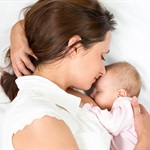Scientific Benefits of Co-Sleeping
Popular media has tried to discourage parents from sharing sleep with their babies, calling this worldwide practice unsafe. Medical science, however, doesn’t back this conclusion and prove the benefits of co-sleeping (See Safe Co-Sleeping Research). In fact, research shows that co-sleeping is actually safer than sleeping alone (See Co-Sleeping: Yes, No, Sometimes?). Here is what science says about sleeping with your baby:
Sleep more peacefully
Research shows a benefit of co-sleeping is infants virtually never startle during sleep and rarely cry during the night, compared to solo sleepers who startle repeatedly throughout the night and spend 4 times the number of minutes crying 1. Startling and crying releases adrenaline, which increases heart rate and blood pressure, interferes with restful sleep and leads to long term sleep anxiety.
Stable physiology
Studies show that infants who sleep near to parents have more stable temperatures 2, regular heart rhythms, and fewer long pauses in breathing compared to babies who sleep alone 3. This means babies sleeps physiologically safer.
Decreases risk of sudden infant death syndrome
Worldwide research shows that the SIDS rate is lowest (and even unheard of) in countries where co-sleeping is the norm, rather than the exception 4, 5, 6, 7, 8, 9 (See SIDS: The Latest Research on How Sleeping With Your Baby is Safe). Babies who sleep either in or next to their parents’ bed have a fourfold decrease in the chance of SIDS 10. Co-sleeping babies actually spend more time sleeping on their back or side 1 which decreases the risk of SIDS. Further research shows that the carbon dioxide exhaled by a parent actually works to stimulate baby’s breathing 11.
Long term emotional health
Co-sleeping babies grow up with a higher self-esteem, less anxiety, become independent sooner, are better behaved in school 12, and are more comfortable with affection 13. They also have less psychiatric problems 14.
Safer than crib sleeping
The Consumer Product Safety Commission published data that described infant fatalities in adult beds. These same data, however, showed more than 3 times as many crib related infant fatalities compared to adult bed accidents 15. Another recent large study concluded that bed sharing did NOT increase the risk of SIDS, unless the mom was a smoker or abused alcohol 16.
Click here for more of Dr. Sears’ research on co-sleeping.
1. McKenna, J., et al, “Experimental studies of infant-parent co-sleeping: Mutual physiological and behavioral influences and their relevance to SIDS (sudden infant death syndrome).” Early Human Development 38 (1994)187-201.
2. C. Richard et al., “Sleeping Position, Orientation, and Proximity in Bedsharing Infants and Mothers,” Sleep 19 (1996): 667-684.
3. Touch in Early Development, T. Field, ed. (Mahway, New Jersey: Lawrence Earlbaum and Assoc., 1995).
4. “SIDS Global Task Force Child Care Study” E.A.S. Nelson et al., Early Human Development 62 (2001): 43-55
5. A. H. Sankaran et al., “Sudden Infant Death Syndrome and Infant Care Practices in Saskatchewan, Canada,” Program and Abstracts, Sixth SIDS International Conference, Auckland, New Zealand, February 8-11, 2000.
6. D. P. Davies, “Cot Death In Hong Kong: A Rare Problem?” The Lancet 2 (1985): 1346-1348.
7. N. P. Lee et al., “Sudden Infant Death Syndrome in Hong Kong: Confirmation of Low Incidence,” British Medical Journal 298 (1999): 72.
8. S. Fukai and F. Hiroshi, “1999 Annual Report, Japan SIDS Family Association,” Sixth SIDS International Conference, Auckland, New Zealand, 2000.
9. E. A. S. Nelson et al., “International Child Care Practice Study: Infant Sleeping Environment,” Early Human Development 62 (2001): 43-55.
10. P. S. Blair, P. J. Fleming, D. Bensley, et al., “Where Should Babies Sleep – Along or With Parents? Factors Influencing the Risk Of SIDS in the CESDI Study,” British Medical Journal 319 (1999): 1457-1462.
11. SIDS book, page 227, #162
12. P. Heron, “Non-Reactive Cosleeping and Child Behavior: Getting a Good Night’s Sleep All Night, Every Night,” Master’s thesis, Department of Psychology, University of Bristol, 1994.
13. M. Crawford, “Parenting Practices in the Basque Country: Implications of Infant and Childhood Sleeping Location for Personality Development” Ethos 22, no 1 (1994): 42-82.
14. J. F. Forbes et al., “The Cosleeping Habits of Military Children,” Military Medicine 157 (1992): 196-200.
15. D. A. Drago and A. L. Dannenberg, “Infant Mechanical Suffocation Deaths in the United States, 1980-1997,” Pediatrics 103, no. 5 (1999): e59.
16. R. G. Carpenter et al., “Sudden Unexplained Infant Death in 20 Regions in Europe: Case Control Study,” Lancet 2004; 363: 185-191.
Dr. Sears, or Dr. Bill as his “little patients” call him, has been advising busy parents on how to raise healthier families for over 40 years. He received his medical training at Harvard Medical School’s Children’s Hospital in Boston and The Hospital for Sick Children in Toronto, the world’s largest children’s hospital, where he was associate ward chief of the newborn intensive care unit before serving as the chief of pediatrics at Toronto Western Hospital, a teaching hospital of the University of Toronto. He has served as a professor of pediatrics at the University of Toronto, University of South Carolina, University of Southern California School of Medicine, and University of California: Irvine. As a father of 8 children, he coached Little League sports for 20 years, and together with his wife Martha has written more than 40 best-selling books and countless articles on nutrition, parenting, and healthy aging. He serves as a health consultant for magazines, TV, radio and other media, and his AskDrSears.com website is one of the most popular health and parenting sites. Dr. Sears has appeared on over 100 television programs, including 20/20, Good Morning America, Oprah, Today, The View, and Dr. Phil, and was featured on the cover of TIME Magazine in May 2012. He is noted for his science-made-simple-and-fun approach to family health.

